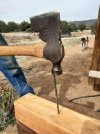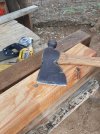David Martin
Moderator
- Joined
- Apr 7, 2008
- Messages
- 19,520
Not cutting wood but using it. Today we have been adding another 8' to the pole barn. I used my Plumb victory (circa 1945) to drive #60 ring shank nails, to hold 2- 4"X 4" post together. These were used as a post. Using it to notch and nail, this hatchet excels at these task. It has good weight in it's head. For non-carpenter ax men, these are 6" hard to drive specialty nails. That won't pull out! They are used to build rural wood bridges and barns, ect.. It drove those in without hesitation. Plenty of good force. Glad I had this tool for the job. DM




Last edited:





